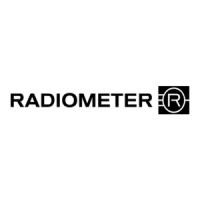ABL90 FLEX reference manual 8. Parameters
8-37
Oxyhemoglobin dissociation curve (ODC)
These equations account for the effect of FCOHb on the shape of the
Oxyhemoglobin Dissociation Curve (ODC) in accordance with the Haldane
equation.
Eq. 46 16,18:
oooo
xxktanhh)xx(yy
where k
o
= 0.5343
Eq. Description
46.1
xln p
46.2
s
s
-1
lny
46.3
o
o
o
yln
1-
s
s
where s
o
= 0.867
46.4 x
0
= x
00
+ a + b = In(p
00
) + a + b where p
oo
= 7 kPa.
The actual position of the ODC in the coordinate system (ln(s/(1–s)) vs ln(p))
used in the mathematical model, is expressed by equations 46.3 and 46.4.
The symbols "a" and "b" reflect the ODC displacement from the reference
position to its actual position in this coordinate system:
"a" describes the displacement at 37 C.
"b" the additional displacement due to the patient temperature difference from
37 C.
The reference position of the ODC was chosen to be the one that corresponds to
the default value for p50(st) = 3.578 kPa, which is traditionally considered the
most likely value of p50 for adult humans under standard conditions, namely:
pH = 7.40
pCO
2
= 5.33 kPa
FCOHb, FMetHb, FHbF = 0
cDPG = 5 mmol/L
ODC equations
The ODC
reference
position

